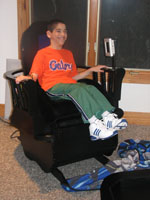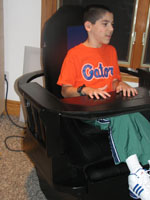Designers: Phil Nicholson, Justin Hilliard, and Josh Lundberg
Supervising Professor: Larry Bohs
 INTRODUCTION
INTRODUCTION
Our client is a 13-year-old boy with cerebral palsy. The purpose of this project was to develop a soothing environment for him to find comfort when he is anxious. The Soothing Rocking Chair includes vibration and audio output, with easily usable controls to accommodate his degree of motor capability. In addition, the device includes a removable desk workspace to provide a place to read, and a digital photo album for him to review his own photos.
SUMMARY OF IMPACT
The client’s mother commented, “The innovative combination of music, rocking and vibration has been of therapeutic value to our son. When he is feeling upset and anxious he chooses to retreat to his chair and ‘chill out’. [He] will be having orthopedic surgery this summer, and the wide seat and reclining angle of this rocking chair will really help facilitate his recovery. I know he will spending a lot of time in his chair this summer.”
TECHNICAL DESCRIPTION
The Soothing Rocking Chair (Figure 1) consists of a gliding rocking chair that incorporates audible, tactile, and visual stimulation elements to engage our client’s personal interests in addition to providing a comfortable and soothing environment. A Boom Chair 2.0 (Lumisource, Inc.), which includes vibration and audio elements, forms the foundation for the device. The chair is mounted in a supporting wooden frame, modified from a SafeRocker Deluxe Adult Glider Rocker (Foundations, Inc.).
The Boom Chair includes vibration motors throughout the chair, with large knobs on the side of the chair that allow the client to adjust the intensity of the vibration and audio intensity. RCA jacks on the chair are used to play music through the speakers. A modified CD player connects to RCA jacks on the chair, allowing the client to select his own music. The CD’s remote is hard-wired to large pushbuttons, mounted to the chair, giving the client easy control of play, pause, skip, and stop functions.
A custom work desk allows the client to read books, draw pictures, or do homework while sitting in the chair. The desk features a two-inch recessed work area that is large enough to fit a standard 8.5″ by 11″ piece of paper. The desk features a locking mechanism with quarter-inch spring pins inserted into dowels that connect the desk to the chair, which prevent the desk from tipping. An assistant is required to add and remove the desk while the user is in the chair.
 Because our client enjoys taking pictures and viewing them on the computer, a digital photo album (CRDMP4, Ziga USA, Inc) is mounted onto the structure supporting the chair. The album is mounted to a dowel rod, which slides into a custom slot on the chair so that the album can easily be attached or removed.
Because our client enjoys taking pictures and viewing them on the computer, a digital photo album (CRDMP4, Ziga USA, Inc) is mounted onto the structure supporting the chair. The album is mounted to a dowel rod, which slides into a custom slot on the chair so that the album can easily be attached or removed.
To provide additional stability to the Soothing Rocking Chair, 8″ long anti-tilt extensions attach to the rear legs, making it impossible for the client to tip the chair backwards. To help him enter and exit the chair safely, external wooden armrests are attached to each side of the chair. Extending approximately four inches above the original armrests, the external armrests help stabilize his body as he enters and exits the chair. A rear wooden connecting arm attaches between both external armrests to ensure that the client cannot fall out of the chair into what had been a void between the external armrests and the Boom Chair. Cost of parts was about $800.